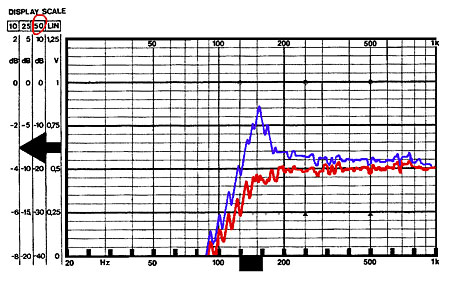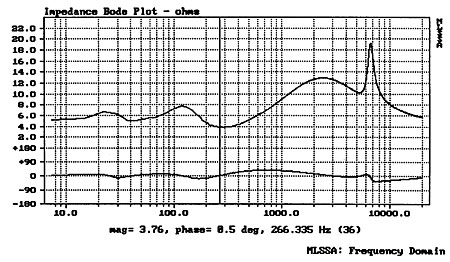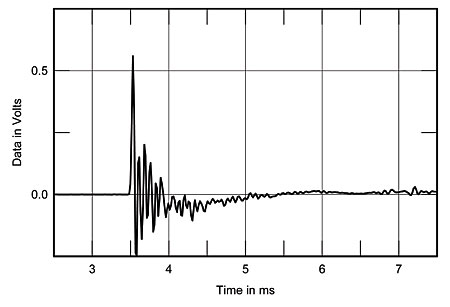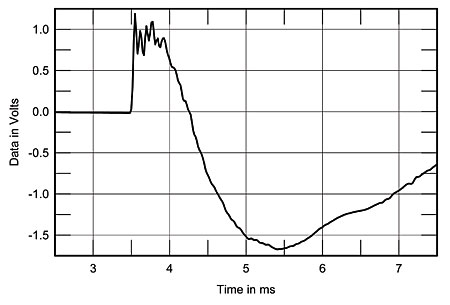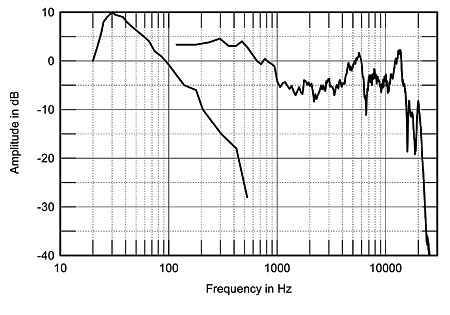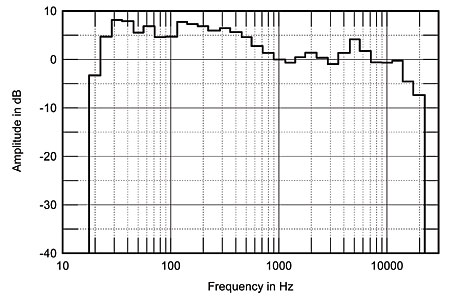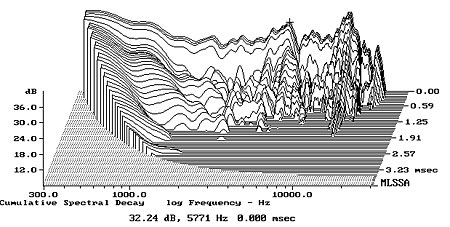

Carver Amazing Loudspeaker (Platinum Edition)
Dick Olsher, February, 1990
![]()
Even to a nontechnical observer, someone without a deep grasp of the germane technical issues, the Amazing Loudspeaker should indeed prove a source of amazement. First of all, there's no box. Don't mistake the back grille for an enclosure—if you pass your hand along the Amazing's behind, you'll realize that the grille is merely a cosmetic cover; you can actually stroke the woofer magnets if you're so inclined. Yet without an enclosure or electronic trickery, this speaker boasts excellent dynamic headroom and true flat bass extension almost to 20Hz. Just think of the woodworking costs inherent in trying to coax such low-end performance from a conventional box speaker. The savings in carpentry have been put toward one heavy-duty ribbon design. The Amazing begins to sound like an incredible bargain at its modest (by high-end standards) asking price. What's the catch? Fundamentally, the answer lies in superior engineering. And, as Bob Carver will readily admit, good engineering isn't inherently any more costly than bad engineering.
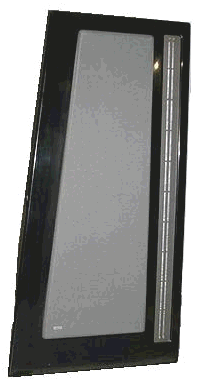
It was the promise of greatness that led me to request a review sample from Carver. What eventually arrived was the Amazing's new Platinum Edition. There's also a Silver Edition, a little-brother version with only three woofers per side as opposed to the Platinum's retinue of four 12" woofers. These new Amazings have not been reviewed elsewhere, and differ from the old Amazing in several ways: the ribbon is now pleated for better low-frequency extension and power handling; the new ribbon has more excursion and, to minimize acoustical interference, is one long, continuous design instead of the two shorter segments of the older design.
The elegant fascia of the speaker commands respect and bears more than a passing resemblance to the Apogee designs. However, to characterize the Amazing as a ripoff of the latter would be grossly unfair to Carver. For example, it so happens that the asymmetry of the front baffle is important for smoothing out the bass response of any dipole radiator. A rectangular baffle would have worked, but not as well as an irregular one. So to accuse Carver of mindless imitation in this case makes about as much sense as accusing Ford of copying GM because all of Ford's cars also have four wheels.
The woofer section
More accurately, the subwoofer section, because undeniably the Amazing is capable of subwoofer performance. The 1980s saw the resurgence in several subwoofer designs of the finite baffle, once the low man on the totem pole of baffles. Some of you may recall the Enigma subwoofer, now out of production, and of course more recently the Celestion 6000 subwoofer. In both, electronic equalization is used to compensate for the baffle's LF rolloff down to the woofer's free-air resonant frequency. At frequencies where the average baffle dimension is smaller than half a wavelength, the front-to-back cancellation characteristic of a dipole radiator takes place.
One of the nice features of finite baffles is that the LF rolloff is a gentle, predictable, easily equalizable 6dB/octave down to the driver free-air resonance—below which the response goes to hell at the rate of 18dB/octave. Even so, the bugaboo for such designs remains achieving sufficient dynamic headroom in the deep bass. Push the woofer or woofers extra hard and you run out of voice-coil excursion sooner than you would with that same driver in a box.
The Celestion 6000 is a good case in point. The small-signal response looks terrific with a half-power bass frequency of about 25Hz. But below 40Hz, you'd be lucky to hit 100dB at a realistic listening position even in a small room. Folks, in the deep bass 100dB spls are quite polite.
Bob Carver's innovation lies in his startling reversal of the roles of driver and baffle. Carver's correspondence on this subject is quite eloquent, and the following description is based largely on his writing. Traditionally, the drive-unit alignment is of fairly low Q. (Q stands for "Quality Factor" and is a measure of how sharply defined a resonant peak or dip is.) For example, a woofer Q of 0.42 is considered about optimum for a bass-reflex design. The cabinet, being of high Q, pushes the overall response Q to about 1 in a properly designed system. Bob's insight was to regard the finite baffle as the low-Q or overdamped element in the system and let the high Q of the woofer bring about an overall system Q of 1. Simply put, the idea is to introduce an under-damped or peaky woofer into the baffle and let the peak in the woofer response compensate for the front-to-back bass cancellation of the baffle.
Sounds simple at first blush, but boy, are there technical difficulties lying in the bush, as Bob will only too gladly tell you. He's spent the last two and a half years addicted to the notion of perfecting this planar speaker—until recently to the detriment of Carver the Company and his own personal life. Speaker designers are a breed apart, junkies whose highs are derived from doing battle with the laws of physics. And to judge from my recent encounter (of the third kind) with Bob, the fire still burns bright. His enthusiasm for the Amazing and his untiring drive to improve them clearly go beyond the call of duty.
To underdamp a woofer you have to reduce the size of the magnet. As the magnet size is reduced, the electrical Q of the driver increases, and with it its total Q. The problem is that the efficiency of the woofer is reduced at the same time. The absurd conclusion of this scenario is zero magnet, zero efficiency, and of course zero cone motion. To improve the efficiency of a woofer with a miniature magnet it is therefore necessary to drastically reduce its moving mass. The idea is to try to keep constant the ratio of force to mass, hence a constant woofer acceleration factor. Because most of the moving mass is represented by the cone, that's where you have to cut. What you end up with at the end is a woofer with a gossamer-thin cone and an unbelievably tiny magnet—quite unlike the traditional woofer with its heavy cone and beefy magnet.
So radically different was Carver's woofer design that Tonegen, its Japanese manufacturer, refused at first to produce it. It took a personal visit by Bob to convince them that that was truly what he wanted. The danger, according to Bob, is that there is a tendency on the part of the audiophile who sees this tiny magnet to say, "Ah-ha, Carver has out-cheapied himself and is just screwing us and ripping us off." But it just would not work any other way. Reducing the moving mass, however, is in itself inadequate to confer a decent efficiency; ultimately, one has to resort to a different strategy to achieve a reasonable system sensitivity.
There it is: sensitivity. A term so often confused with efficiency that, in many audiophiles' minds, the two concepts are synonymous. Efficiency is a fundamental driver property, determined essentially by driver parameters, that relates (for example) how efficiently a woofer converts electrical input power to acoustical output power. Sensitivity, on the other hand, is a system parameter. For example, a system with ten inefficient woofers may put out more total power than a system with a single more efficient woofer. Thus, there is combined "strength" in numbers. And from a practical standpoint, most of us could care less about driver efficiency—as long as the bottom line is excellent sensitivity.
Those of you familiar with Small-Thiele theory may be reaching for a pen and pad just about now, getting ready to fire off a letter to the Editor. I know what you're thinking: "How can DO say that? Haven't I seen a design equation somewhere that shows efficiency increasing with box volume"? Well, let me save you the postage. It's only a myth; appearances can sometimes be deceiving. And even Richard Small himself will tell you that driver efficiency is determined almost entirely by driver parameters, not box volume. It can't be any other way; if efficiency did increase with box volume, you'd have infinite efficiency in an infinite baffle. Nonsense. Big, efficient woofers do require big boxes for proper bass alignment, and for that reason big box designs are more efficient. But it's not because of the box; rather, the woofer.
Back to the idea of using multiple woofers to improve system sensitivity. This is not a practical approach for a box speaker. Once you optimize the design for a given woofer to yield maximally flat bass response or whatever, mounting another woofer on the front baffle screws up the bass alignment (the exception is "isobarik" or compound loading). The two woofers in the same box will produce a peaky, non-flat response with reduced bandwidth. The reason is that the acoustic compliance of the woofer pair is doubled, which in turn requires a box volume twice as large. So to keep adding woofers to a box design requires an ever-increasing penalty in terms of box volume. This is not a problem, however, for finite baffle designs.
One of the advantages of the finite baffle is that its bass alignment is unaffected by the number of woofers used—the designer is free to use as many drivers as he pleases to keep pushing the system sensitivity higher and higher. Carver uses four woofers per side in the Platinum Edition because that's all the room there is, but I'm sure he'd have opted for more, space permitting, and of course only if the ribbon sensitivity could keep pace. The end result is a very respectable sensitivity spec of 88dB—good enough in this respect to compete with many box speakers.
The Q of the Amazing's bass alignment is around 1, considerably higher than the 0.5–0.7 range most designers opt for. Don't expect tight, well-defined bass from such a design. This, according to Bob, is just the sort of bass quality he likes—"a warm, rolling bass."
The ribbon
The ribbon assembly flanks the woofer array on the inside edge of the baffle. If you look closely you can see that the planar "voice-coil" consists of four strips of pleated aluminum foil running the length of the assembly. The strips are joined top and bottom to form a continuous loop. The aluminum is glued to a Kapton backing stretched over a particle-board frame and clamped on all sides with a foam suspension. The foil is sandwiched between two layers of magnets located front and back. There's a total of 36' of ceramic magnets per side that provide the magnetic push-pull force for the ribbon. The Kapton is claimed to be very strong, dimensionally stable, and capable of tolerating extreme temperatures—a perfect recipe for a voice-coil former. The glue used is said to provide damping for the internal resonances of the aluminum.
Being a purist, I naturally feel obliged to point out that, strictly speaking, this sort of design is not a ribbon in the classic sense in at least one respect: The foil operates in the peripheral or leakage field of the magnets instead of being suspended directly between the north and south poles. For most folks, Apogee included, this sort of design qualifies as a ribbon, so I'll let it go for now.
The ribbon operates full-range above about 100Hz, with useful output to about 20kHz. There's a second-order crossover network at around 100Hz. However, I have hedged about the details here because the design changed before my eyes as the review progressed (more about that later). While there are no crossovers in the critical midband, there is at least one pot (hedging again) in the signal path. Sample 1 of the Amazing featured an upper-midrange control, while sample 2 had no less than two pots, the additional pot being a high-frequency control. Something unique to Sample 1 were two small foam rectangles mounted top and bottom on the back side of the ribbon. I've dubbed them "training bras" because, according to Bob, their function is to provide some damping for the ribbon until it breaks in—after which they may be discarded (though this is not spelled out in the manual).
The bass resonance for the ribbon is claimed to be 75Hz. In Santa Fe, after an extensive break-in period of over 100 hours, we measured a bass resonance centered at 150Hz. At Santa Fe's 7000' altitude, granted, I would expect the resonant frequency to climb because of the reduced air load; for the ribbon, I would even be willing to concede the possibility of a 25% increase. But a 100% increase cannot be explained by blaming Mother Nature, as Bob is inclined to do. I would rather point an accusing finger at Carver's quality-control procedures.
I'm also worried about the selection of a crossover frequency so darn close to the ribbon resonance. The extreme phase shifts that accompany a resonance make it a bitch to design a network with flat amplitude response in the crossover region. As a rule of thumb, one should choose a crossover point at least an octave away from a major driver resonance. A driver can be modeled as a bandpass filter. In its pass band, removed from the bass resonance and HF rolloff, a driver is known to be minimum-phase and thus much more amenable to conventional filter design. Did Carver succeed? Well, in my own measurements and his, there is a notch in the response between 100 and 150Hz, apparently due to the crossover. Of course, there's the possibility that this is caused by a room mode, but I rather doubt it.
Bob provided me with measurements he made in a hi-fi store at about 4 meters on-axis, comparing the response of the Amazing to that of the Quad ESL-63. Bob figured that since the Quad has no bass crossover, its response would be seamless and would highlight any problems with the Amazing's crossover. With both speakers and the mike in the same physical location, the response curves superimpose very nicely at 75Hz, but there's a 3dB notch in the response of the Amazing relative to that of the Quad, centered at 110Hz.
Virtues of directivity
Conventional box speakers radiate omnidirectionally in the bass. As signal frequency increases, however, the polar response narrows significantly. By the time the tweeter tweets above 5kHz, the response is pretty much confined to a cone with a half angle of 30°. All conventional tweeters beam sooner or later, and may be said to possess increasing directivity as a function of frequency. Looked at as a whole, the directivity of a garden-variety loudspeaker resembles the shape of a pyramid: low-directivity or broad radiation in the bass while taking on an increasingly narrow radiation profile at higher frequencies. In contrast, a dipole radiator has a much narrower radiation pattern, at least through the lower octaves. The pattern resembles a figure eight, with radiation lobes to the front and back and very little side-directed energy. One advantage of the latter pattern is that it significantly reduces early lateral room-boundary reflections and their resultant colorations. There is simply less energy splashed onto the side walls, floor, and ceiling.
I firmly believe that a dipole radiator represents a significant step toward solving the room/loudspeaker interface problem. Early reflections are anathema to accurate reproduction of the soundfield captured by the mikes at the concert hall. These reflections, even if spectrally similar to the direct sound, interfere with it to produce a comb-filter effect that colors perceived timbres. Reflections arriving at the ears during an initial 10ms window—after the direct sound has stopped—are the most troublesome because they are higher in amplitude compared to later arrivals and are not well discriminated against by the ear/brain system. Room treatment is therefore essential to suppress the room's sonic signature. After all, do you want to hear your room's reverberation or the original soundfield?
I've had good results with a dead-end/live-end sort of treatment with the speakers located at the dead end of the room. I'm therefore mystified by Carver's references to the beneficial effects of 6ms reflections when the Amazings are placed 3' from the front wall of the listening room. These reflections are claimed to increase the spaciousness of the soundstage. Well, I would have thought that rear-wall reflections or possibly a delayed rear channel would have done that. But in my opinion, Carver's suggestion is a recipe for destroying the accurate transduction of the original soundfield on the recording. I'm making a tacit assumption here that the soundfield captured during the recording session is worth preserving. This may be a poor assumption in the case of multi-miked pop recordings, in which case the additional adulteration of the room may actually be desirable. In the case of properly executed purist recording techniques, the recorded soundfield is rich with spatial clues and incorporates the right blend of direct/diffuse sound. That's the sort of information I'd like to preserve in my listening room. Unfortunately, this is much more difficult to do than I've so far indicated.
It's a fact of life that most of us listen in semi-reverberant environments. Room treatments are most effective at higher frequencies, say above 5kHz. At much lower frequencies it's very difficult to dissipate sound energy very quickly. As a result, unless you're glued to the loudspeakers, a significant portion of the sound energy at your listening position is due to room reflections. A critical distance may be defined at which the reverb energy just equals the direct sound energy. The basic problem is that this critical distance changes with frequency. It would be highly desirable to keep the ratio of reverb to direct energy constant at the listening seat. But because directivity or beaming typically increases with frequency, this goal is impossible to achieve. Recall that the average speaker is omnidirectional in the bass. It pumps lots of bass energy off-axis; together with the fact that room absorption is ineffective in dissipating bass energy, this assures that reflected energy is bass-rich and treble-shy. As directivity increases, more energy is concentrated on-axis and the direct component of the total sound increases. Finally, above about 5kHz, the absorption of highs by room surfaces, together with the on-axis treble beaming, combine to make the treble sound almost completely direct.
This is an important concept to understand. It explains, for example, why two speakers that measure exactly alike on-axis sound different—in the same room. The answer, of course, is different directivity patterns which change the character of the room reverb. Line-source tweeters like those in the Amazing are by their nature more beamy than a typical dome tweeter. Thus, if you've optimized your system for a dome-based loudspeaker, substitution of a line ribbon at the same position will result in a noticeably brighter balance. Why? Because the direct/reverberant sound ratio starts to increase at a lower frequency for line sources. This predominance of direct sound will emphasize overtone structures in the upper octaves, imbuing timbres with a bright, steely character. The solution is to either move farther back from the speaker or experiment with treble rolloff (footnote 1).
So what response is "correct" for a quasi-line-source design like the Amazing? It would be a definite mistake to equalize the Amazing to be flat on-axis in the near field. I learned this the hard way. I tried it, and had to duck the razor blades the Amazing hurled at the listening seat. Three meters away, the sound was excruciatingly bright. An even bigger blunder would be to equalize the Amazing to be flat at the listening seat. The superimposition of a reverb curve deficient in highs over a flat direct-sound curve naturally results in a listening-seat balance featuring high-frequency rolloff. That's the correct tonal balance. An attempt to flatten this composite curve by jacking up the direct-sound contribution will significantly brighten timbres. Trust me, you'll be reaching for the cotton balls.
Footnote 1: For a more technical exposition of these concepts, see Professor Han's "Frequency Responses in Acoustical Enclosures," AES Preprint 2452(F-3), 1987.—Dick Olsher
